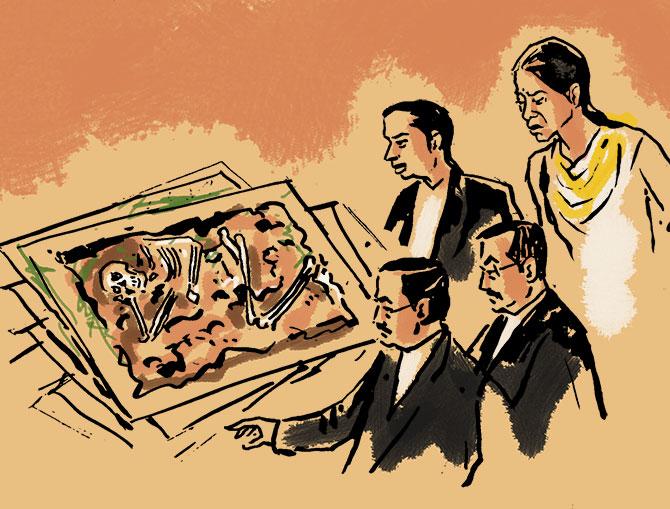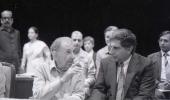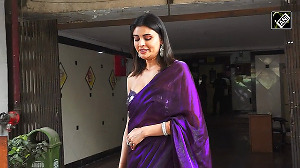Many pictures showed The Skeleton Named Sheena.
For the purpose of the photographs, the skeleton had been re-assembled and looked straight at the camera.
Vaihayasi Pande Daniel reports from the Sheena Bora murder trial.
Illustration: Dominic Xavier/Rediff.com

An Indian court case is very much like a 2,000-piece puzzle.
For the number of pieces it has.
For the painstaking manner in which the pieces are assembled.
For the snail-like slowness with which the bigger picture emerges.
For the confusing blurriness that each piece offers, individually, before the big picture begins to unfold.
It could even be a 3,000-piece or a 4,000-piece puzzle. And the more pieces there are, the more expensive the puzzle is.
In real life the more pieces the trial puzzle has the more costs the case extracts of its participants in both time and money.
And it is blood money.
In the Sheena Bora murder trial, evolving at Courtroom 51 at Kala Ghoda's Mumbai city civil and sessions court, the Grand Puzzle Master is the CBI Special Prosecutor Ejaz Khan.
Khan, who hails from Nagpur, the son of a doctor and an army officer, but is posted to New Delhi, pulls many late nights reading case material and deciding strategically which puzzle piece to push forward at each hearing.
This senior prosecutor, aided by his colleague Man Prakash (who recently joined the CBI from Rajasthan) and the henna-haired P K B Gaikwad, prides himself on being -- no matter the dizzying number of pieces -- a lightning-quick case puzzle assembler.
Defence lawyers for Accused No 1 Indrani Mukerjea, Accused No 2 Sanjeev Khanna and Accused No 4 Peter Mukerjea, on the other hand, have another relationship with the same puzzle.
They are constantly pointing out when a puzzle piece just does not fit, no matter what the CBI might try.
As someone who has viewed nearly each piece disclosed till date, one patiently, with bated breath, waits for even a corner of the picture to be completed.
Thursday, July 4, 2019 Khan brought to court, in his bundle of files, his newest puzzle piece.
It was a little, odd-shaped jagged piece connecting, in sequence, to the Raigad district part of the jigsaw.
But also a key piece that joined a murder in Mumbai with a body found on the perimeter of a jungle bordering the Pen-Khopoli road in that district.
Assistant Police Inspector Sandip Parmeshwar Dhande, 36, who deposed on Thursday as PW 53, now posted to Solapur, belonged to that puzzle piece.
Back in the summer of 2012 he was a sub-inspector working at the Pen police station, Raigad, nearly 80 km from Mumbai and this court.
He was the man who wrote up the inquest and spot panchnamas** for the half-burnt skeleton found about 12 km from his police station in a grove of mango trees near the village of Gagode Khurd, that was later buried there, unidentified.
In 2015, this skeleton was discovered to be Sheena Bora's.
In his testimony to the court, Dhande was the first Raigad witness to mention that he felt, on first glance at the decomposing skeleton, that it belonged to someone who had been murdered.
Dhande recounted in Marathi: "When I reached the spot (Havaldar K K) Mhatre, (Nayak Vinod) Bhagat and the police patil* (Ganesh Dhene) were there. I saw the burnt skeleton. The leaves aaju-baaju (surrounding) the skeleton were also burnt. There was a rectangular wire frame. And kapde tukde (pieces of cloth)."
Khan asked in Marathi: "What was the condition of the body?"
Dhande: "Its laam (long) hair was burnt. I suspected that it must be a murder."
He said he began searching the area around the skeleton for clues to strengthen his hypothesis.
In his testimony in chief on Thursday, when Dhande took the stand, in his khaki police uniform, he did not elaborate in any detailed way why he thought it was murder.
Dhande was also the first Raigad witness to put on record the clothes or cloth associated with the skeleton and the wire frame, that might have belonged to the suitcase burnt there too, in which Sheena's body was allegedly brought from Mumbai.
The police officer -- high cheekbones, a flat nose, a broad moustache, narrow eyes, medium height, a muscular-looking man, with puffy biceps --n had three stars on his epaulets and an insignia-bearing peaked hat that he placed on the shelf in front of the witness stand.
His brawny look suggested, illogically, that he might be no pushover in the witness stand. And he wasn't.
Dhande stood in the box like he owned it, his hands, spaced widely apart, held down the rail like it was a speaker's podium. Or he crossed them in front of his chest. When the going was not good he would look up at the ceiling or leaned down flexing his back.
A serious, attentive witness, unlike many of his predecessors, he did't look cowed down and at points took the lawyers on head on. He was considerably more colourful and more chirpy -- frequently using his hands to make a point or switching into English -- than other po-faced police witnesses and though there were stumbles, he tried to nimbly negotiate himself out of tight corners.
The corners were rather tight.
Further recounting the events of May 23, 2012, Dhande said he called his superior officer, Police Inspector Suresh Mirghe. Then Dr Sanjay Thakur showed up to do the post-mortem. So did deputy superintendent of police, Pen, Pradeep Chavan.
Once the post mortem was done and the samples extracted: "Thereafter, we buried the sangaada (skeleton) in the baju khadda (nearby pit) covered in kapda (cloth). So junglee janvar (animals) should not eat it we covered it with (cloth, earth and a stone). The body parts were carried to the police station by Bhagat. I went back to the police station and then on night patrol."
He was called in 2015 to give a statement by the Khar police, north west Mumbai, who began the investigation into Sheena's murder.
Peter's defence lawyer Shrikant Shivade commenced his cross-examination of Dhande, as he invariably does with police officers (his father was a policeman), asking if they are obliged to follow the rules and directives of the Maharashtra Police Manual. And about his duty to note down his daily activities in his police diary.
Dhande said he was obliged to do so.
CBI Special Judge Jayendra Chandrasen Jagdale gave a long smile. So did Shivade.
Lawyers, like actors, try out many roles, with elan. Shivade had abandoned his medical persona of last week, assumed for the cross-examination of the post-mortem doctor, and donned the slightly gruff, reeking-of-nobility costume he customarily wears for dealing with policemen, where he often underlines the duty of law enforcers.
The advocate began to carefully unpack for the court the extent of Dhande's knowledge of half-charred skeletons.
Had he seen skeletons before?
Yes.
A partially-burnt corpse?
No.
What were the differences between a regular corpse and a burnt one?
Khan intervened, telling Shivade he was asking a police officer questions that should be asked of a medical officer.
Judge Jagdale, who takes keen interest in a well-constructed 'cross', arbitrated: "If he knows he should answer."
Dhande caught the cue: "A doctor will know. You ask a doctor."
Shivade laughed, but persisted wondering why he would not be able to tell the difference between a burnt and non-burnt skeleton.
Dhande was obstinate. In Marathi: "I can't say."
Shivade to Khan: "He will get caught in this. Better he answers."
Dhande, heels dug in, echoing Khan: "I am not an MO (medical officer)."
The advocate chose an alternative route, asking the police officer about the colour of the bones of the skeleton. And if they were blackish or burnt in some places.
The policeman looked nonplussed and glanced towards Khan. He was not sure what to answer.
He tried to safely negotiate a half answer, saying they were burnt in parts.
The lawyer further checked: "Was it guesswork that made you feel the said blackish portions might be due to burning?"
Dhande: "Ho (Yes)."
Did he feel the skeleton was different from other skeletons he had seen?
Did he feel the skeleton was different because it was burnt?
Were the bones burnt or not?
Dhande hesitated, not answering.
Shivade began to lose his cool. "He can't run away from my question."
Khan, defending Dhande: "Where is he running?"
Dhande offered: "I cannot state if the bones were entirely burnt or not."
Choosing another tack, Shivade asked Dhande if he came across a skeleton was burnt what inferences did he draw.
Dhande puzzled: "Inferences majhe? (Inferences means?)"
Deftly, the lawyer asked Dhande to list one by one his conclusion after seeing the skeleton.
First inference that the person is dead.
Second inference would be, did it happen naturally or unnaturally?
Dhande, not happy with yes and no answers, would from time to time hopefully request the judge: "Explanation?..."
Judge Jagdale sharply: "Not asking for an explanation."
Apart from these two inferences, could he think of any other inferences?
Dhande shook his head, looked down.
Shivade: "Murder or suicide. Fourth relates to the burnt skin..."
Khan retorted on Dhande's behalf: "Hypothetical. Can you confine yourself to the crime?"
The discussion wandered off onto the conclusions drawn from the simple decomposition of a corpse and more.
Dhande interposed volunteering: "In the present case, the surroundings were also burnt."
But on furthering questioning he admitted he had not investigated why the surroundings were burnt and they could have been burnt for some accidental reason.
Shivade asked if he had recorded the details of what he found at this scene of crime in his diary.
Dhande hadn't. He then said he wanted to give a submission.
Shivade snapped: "Give it later as an affidavit."
The room laughed. A number of younger lawyers had come to watch Shivade's cross-examination.
The lawyer questioned if it was mandatory for him to record the details of such an important event in his police diary?
Dhande: "Not in detail. Point to point."
Shivade: "Point to point?"
And then in a dramatic tone, "Dhande Saheb murder ghatna mahatvachi nahi ka? (A murder is not an important incident?)"
The judge observed, his eyes twinkling, his moustache bristling with a smile: "This is going on like a departmental enquiry."
Laughter.
Shivade persevered, asking that if Dhande thought it was murder, why hadn't he put it in his diaries.
Moving on, the lawyer asked how correct was his statement to the Khar police.
He quipped mischievously: "When you went to Khar police, did you know your statement better or did they?"
Khan: "How can he answer that?"
Shivade, refashioned it creatively: "Had the Khar police already recorded your statement and then asked you questions?"
A little spat broke out between Khan and the defence lawyers. They accused him of prompting Dhande.
Khan angrily: "I have out-passed all that. I am a hard-core prosecutor. I am a CBI prosecutor..."
He went on, further accusing the lawyers of not being able to handle the witness and transferring the blame to him.
He suggested, "One question, one answer."
The judge: "Their main objection is he is not answering."
Khan: "He will answer you, your Honour."
Shivade probed further, given that Dhande as a policeman was familiar with witness statement-taking, why he had not told the Khar police that the suspicion of murder was on his mind.
The policeman had no logical answer.
Dhande denied any knowledge of how the post mortem on the partially-burnt skeleton took place that day in 2012.
He could not even say if the doctor had used a hammer or a saw (Shivade's eyebrows shot up) or what kind of bottles were used for the body parts and the time of the post mortem.
The cross examination ended just before lunch on Thursday and was scheduled to resume before noon on Friday.
On Friday, in the second half of his cross-examination, Shivade went over the inquest form that Dhande had filled out in 2012, puzzling over why so many columns were either blank or had negative answers.
The form basically lacked information, be it why blood samples, organ samples and thumbprints, had not been taken, or why there were no photographs.
Dhande gave the document a long look and didn't say much except that there were no samples or fingerprints to give. He adjusted his position in the witness box several times. The judge would not hear his "Explanation."
Shivade queried him about his meeting with the CBI at The Spot (as Khan prefers it be referred) later in 2015. Dhande said by then the skeleton had been taken away from the spot and there were only a few ditches at the time.
He had to merely show where the skeleton had been buried.
He could not elaborate almost anything about that visit -- not the depth of the ditches, or how many, or their distance from each other or who else had come along with the CBI.
Shivade: "Why can't you say?"
Dhande gave a stubborn, irritated, answer: "No reason."
He did mention, strangely, that videography and photography of the spot was done then too.
"The CBI officer has threatened to prosecute you for interference and so your statement has been made under the dabbao (pressure) of the CBI," Shivade declared while closing his cross examination.
Dhande gave Shivade a long look and then shook his head.
Indrani's lawyer Sudeep Ratnamberdutt Pasbola focussed, through his concentrated, tenacious approach, on Dhande's declaration that when he saw the skeleton he felt immediately it had been a murder.
The cross-examination didn't kick off very well with Pasbola accusing Dhande of being rude. Judge Jagdale swiftly poured oil on troubled waters.
The lawyer spent about 15 minutes having Dhande re-construct the events of May 23, 2012.
Dhande would not give any approximate timelines for his arrival, his departure, Mirghe’s arrival at The Spot. He said could not remember exact times.
Pasbola in an outburst: "Andazaan! (approximately!)"
The lawyer added: "Not asked exact time. My Lord, I never ask exact time. No one can give exact timing."
Had Dhande called Mirghe from The Spot.
Dhande said he had.
He was then cautious and clever, after a pause, to add that he had not called from his own phone. He could not remember whose phone, "a police karmchari (staffer)" or the network.
Just that he had used a phone that had "range." It was the same when he called the doctor.
Tracing who Dhande had voiced his suspicions of murder to, Pasbola was told he had told his immediate superior Mirghe.
Dhande never pushed his theories of murder with anyone beyond Mirghe. Not even with Chavan, who arrived at the spot a little later. Or Dr Sanjay Thakur. Nor did he check who Mirghe might have told.
Pasbola, doggedly following this line of questioning, slowly made total chutney out of Dhande's gut feeling that the skeleton he encountered in 2012 had been a victim of murder.
He wondered why Dhande had never followed up on his hunch?
Why he had not persisted with it and pushed his theory with his seniors?
Had he told the police control room?
Why had he not told the Khar police?
Wasn't it his duty to file an FIR? As a citizen, let alone a police officer?
Dhande waffled. He had no acceptable answer. He said once had had told his senior, it was up to the senior to take action. And no, he was not passing the buck. That it was the senior's decision.
Like a tailor doing raffu (repeated sewing) in the same spot over and over, Pasbola chewed away at Dhande over this, attempting to elegantly expose his incompetence as a police officer and indirectly, in classic courtroom technique, showing his unreliability as a witness.
In a similar exercise, Pasbola dwelled to on why Dhande had not sent the burnt leaves for testing.
Or more crucially photographed the three most important locations at The Spot -- where the skeleton was discovered, where the post mortem was conducted and where it was buried.
Dhande was gol (clueless). He didn't know why he hadn't or if anyone had.
Towards the end of his cross examination Pasbola asked if any organs from the skeleton had been sent for testing.
Pasbola: "Were there organs in the skeleton?"
Dhande shook his head.
If the skeleton was Sheena's, then, in spite of its half-charred state, or the sun or the rain, the chances of finding some samples of its internal organs intact, one month later, is not unfeasible, theorise lawyers, especially the strongest organ, the uterus.
Pasbola: "The skeleton, photographs, documents have been fabricated at the insistence of the CBI. The (original) photographs have been deliberately and intentionally destroyed. On the insistence and under pressure from the CBI you have said 'I suspected murder'."
Dhande rebuffed Pasbola's allegations. He left the stand to sit out in the corridors with Mirghe, also in court. Mirghe, who retired from the police force on June 30 and lives in Pune, was scheduled to testify after the next witness.
Vijay Kamlakar Lad, 39, was Prosecution Witness 54.
A pleasant-mannered, greying man, who often broke into English, he was a photographer by profession and a resident of Mira Road, a township north of Mumbai.
His testimony in chief conducted by Khan was of a few minutes. He stood the whole time with his hands behind his back at the very edge of the witness box.
Lad had been recruited by the police to accompany them to Gagode Khurd early one rainy morning in August 2015 while they exhumed the skeleton that was said to be Sheena's.
He had taken pictures of The Spot and the exhumation process as well as the skeleton over three or four hours.
His day of work yielded 60 photographs and a CD of videos.
Shivade's cross-examination of Lad was exhaustive too. It illustrated how the photographer, who was a small cog in the wheel in this case, could offer bits and pieces of important information.
The most important were:
- While exhuming, bones were coming out at intervals.
- It took about 20 minutes to retrieve all the bones after the correct location was identified.
- None of the pieces of bone appeared wrapped in cloth.
Lad was not required to hand over either the original data card on which he taken the pics or the pen drive on which he transferred his images and videos to the Khar police.
The climax of this double day -- Thursday and Friday -- and six long hours of hearings was the unveiling in court, of the stack of 60 photographs, that Lad had shot four years before.
The colour pictures showed police workers digging at the site.
The pit from which the skeleton came out didn't look terribly deep and was surrounded by dense undergrowth.
It would have been a miracle to have located the burial spot three years later in the height of the monsoon? Too unbelievable a miracle?
Many other pictures showed The Skeleton Named Sheena.
Looking at pictures of the dried, old relics of a murder was a surprisingly an unemotional, detached moment.
Could she be Sheena? What should one think? Or feel?
For the purpose of the photographs the skeleton had been re-assembled and looked straight at the camera.
The limbs had been placed in a semi-curved position.
The skull was intact, showing no cuts, unless they were at the back.
The bones were white and did not exhibit black patches or signs of burning, Dhande had said.
Indrani, wearing yellow and white and a bindi, wandered over from the accused box to hover behind the backs of the panel of lawyers, looking at the pictures, her face animated by curiosity.
Sanjeev seemed to not want to look at the pictures, ghoulish though they were really not.
Indrani, recently turned approver in the Karti Chidambaram case, commented loudly and knowledgeably to Sanjeev's brother, who had arrived for the hearing from Bengaluru, that the skull did not show the doctor's cuts.
Lad's stint in the witness box was short-lived Friday as legal procedure dictated that the court reconvene for a compliance process on Saturday that would authentically give the defence copies of these photographs and videos.
I met Dhande on the staircase going down, on one of the days. He wanted to know how he had done in the witness box. Diplomacy is a new skill one is learning on this job.
The next hearing, after Saturday, in the Sheena Bora murder case, where Mirghe will finally make an appearance, is scheduled for the second half of July, after Indrani returns from Delhi from her approver appearance/or evidence session.
Peter remains unwell. According to his lawyers his heart is enlarged. Shivade has moved the Bombay high court once again for bail. That hearing is scheduled for July 12.
*Patils are the key officials of many villages in Maharashtra, since not every village has a police station.
**Police record of observation










